As we look ahead to the coming year, many individuals and businesses are wondering about the future of propane prices. Will they continue to rise, or can we expect a decrease in 2024? Understanding the forecast and predictions for propane prices in the upcoming year is crucial for making informed decisions and managing budgets.
In this article, we will delve into the propane price forecast for 2024, exploring the factors that influence propane prices, analyzing market trends, and examining the challenges and opportunities that lie ahead. Whether you rely on propane for residential, commercial, or industrial purposes, stay tuned to discover what the future holds for propane prices.
Factors Affecting Propane Prices
Propane prices are subject to various factors that can cause fluctuations in the market. Understanding these factors is essential for analyzing and predicting the propane price trends in 2024.
Crude Oil and Natural Gas Prices
The prices of crude oil and natural gas have a direct impact on propane prices. Propane is derived from natural gas processing and oil refining. Therefore, changes in the prices of these commodities can influence propane production costs and, subsequently, the overall propane prices.
Weather Events
Weather events like winter storms or hurricanes can significantly affect the demand for propane. During colder months, the demand for propane increases as it is commonly used for heating homes and commercial buildings. Severe weather conditions can lead to a surge in demand, resulting in higher propane prices.
Propane Supply and Demand Balances
The balance between supply and demand plays a key role in determining propane prices. If the supply of propane exceeds the demand, prices may decrease due to an oversupply in the market. Conversely, if the demand for propane surpasses the available supply, prices may escalate.
Propane Inventories in the Gulf Coast Region
The level of propane inventories in the Gulf Coast region, where a significant amount of propane production occurs, can influence prices. Higher inventories can indicate an abundance of supply, potentially leading to lower prices. Conversely, low inventories can create higher demand, driving prices up.
Export Capacity
The capability to export propane is another crucial factor affecting prices. Limited export capacity can restrict the amount of propane available for international markets, potentially causing a surplus in the domestic market and putting downward pressure on propane prices.
Production of Propane from Natural Gas Processing
The production of propane as a byproduct of natural gas processing plays a significant role in pricing. Changes in natural gas production levels can impact the supply and availability of propane, thereby influencing prices.
By considering these factors, analysts can conduct a thorough propane price analysis for 2024 and make informed predictions about potential price fluctuations.
Here is a table summarizing the factors affecting propane prices:
| Factors | Description |
|---|---|
| Crude Oil and Natural Gas Prices | Directly impact propane prices due to their association with propane production |
| Weather Events | Severe weather conditions can affect propane demand and subsequently influence prices |
| Supply and Demand Balances | The balance between propane supply and demand dictates pricing trends |
| Propane Inventories in the Gulf Coast Region | The level of propane inventories in the Gulf Coast region can affect prices |
| Export Capacity | Limited export capacity can impact domestic prices |
| Production of Propane from Natural Gas Processing | Changes in natural gas production levels can influence propane availability and pricing |
Propane Market Trends in 2024
In 2024, the propane market is expected to face additional pressure as a result of robust supply, stagnant export capacity, and elevated inventories. The propane prices at Mont Belvieu, Texas experienced downward pressure towards the end of 2023.
If the market remains well supplied, the price outlook for 2024 may be worse compared to crude oil prices. Propane’s price as a percentage of WTI (West Texas Intermediate) has historically been low due to oversupply in the U.S. Gulf Coast.
Despite these challenges, it is important to analyze the dynamic nature of the propane market in order to identify potential opportunities and make informed decisions. Let’s delve deeper into the key trends shaping the propane market in 2024:
1. Enhanced Supply
The propane market is projected to experience a robust supply in 2024. This can be attributed to increased production from natural gas processing in the United States. As propane production continues to rise, it puts downward pressure on prices, resulting in a highly competitive market.
2. Stagnant Export Capacity
One of the major challenges facing the propane market in 2024 is the limited growth in export capacity. The current export capacity in the Gulf Coast region is not expected to see significant expansion until 2025. This constraint on export capacity can further impact prices and supply-demand dynamics.
3. Elevated Inventories
The propane market is anticipated to have elevated inventories in 2024. This surplus stock can have a downward effect on prices as suppliers try to clear excess production. The balance between supply and demand will play a critical role in determining the overall pricing trends in the market.
“The propane market in 2024 faces challenges such as robust supply, stagnant export capacity, and elevated inventories. It is important for stakeholders to closely monitor these trends to make informed decisions.”
By closely monitoring these trends and understanding their implications, stakeholders in the propane industry can navigate the market more effectively. The ability to adapt to changing dynamics and leverage emerging opportunities will be key for success in 2024.
Propane Market Trends in 2024: A Comparative Analysis
| Trend | Opportunities | Challenges |
|---|---|---|
| Enhanced Supply | – Competitive pricing – Increased market share |
– Price volatility – Excess inventory |
| Stagnant Export Capacity | – Focus on domestic consumption – Encourage local investments |
– Limited access to international markets – Impact on global trade |
| Elevated Inventories | – Potential price advantages – Flexibility in supply |
– Price depreciation – Inventory management challenges |
The comparative analysis above highlights the opportunities and challenges associated with the propane market trends in 2024. It is crucial for industry players to carefully navigate these factors to stay ahead in a dynamic and competitive market.
Propane Production and Exports
Propane production from natural gas processing in the United States has experienced a significant growth in recent years. This has resulted in a major shift from importing more propane than it exports to becoming a net exporter of propane. The increase in propane production can be attributed to advancements in extraction technology and the abundance of natural gas reserves in the country.
As a result of this growth, the United States has established itself as a key player in the global propane market. In 2022, the country’s top export markets for propane included Japan, China, South Korea, and Mexico. These countries rely on U.S. propane to meet their energy needs and support various industries.
The production and export of propane play a crucial role in determining propane prices. Export capacity and the balance between domestic supply and demand have a direct impact on the pricing dynamics of propane. Fluctuations in production levels and export volumes can influence the availability and affordability of propane in the market.
| Propane Production and Exports | Key Points |
|---|---|
| Production Increase | The U.S. has witnessed significant growth in propane production from natural gas processing. |
| Net Exporter Status | The U.S. has transitioned from being a net importer to become a net exporter of propane. |
| Top Export Markets | Japan, China, South Korea, and Mexico are major consumers of U.S. propane. |
| Price Influences | Export capacity and the balance of supply and demand are key factors that impact propane pricing. |
Overall, propane production and exports have experienced significant growth in recent years, transforming the United States into a major player in the global propane market. The export of propane to key markets has fueled the country’s economic growth while also influencing propane prices domestically and abroad.
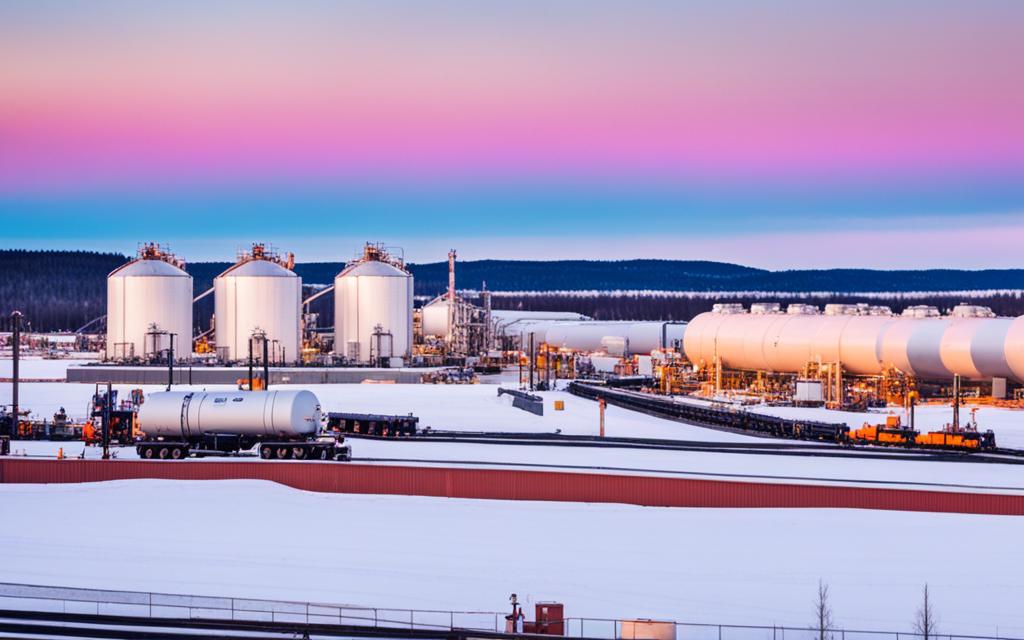
Propane as a Clean Energy Option
Propane is a cleaner option compared to other fossil fuels like coal or oil due to its lower carbon content and higher energy efficiency. It is produced as a byproduct of crude oil refinement and biomass production and can be compressed into a liquid form for transportation.
Propane finds applications in various industries and commercial settings, making it a versatile and accessible clean energy source. Not only is it commonly used for cooking and heating homes, but it is also utilized in hot water systems, providing efficient and reliable energy solutions.
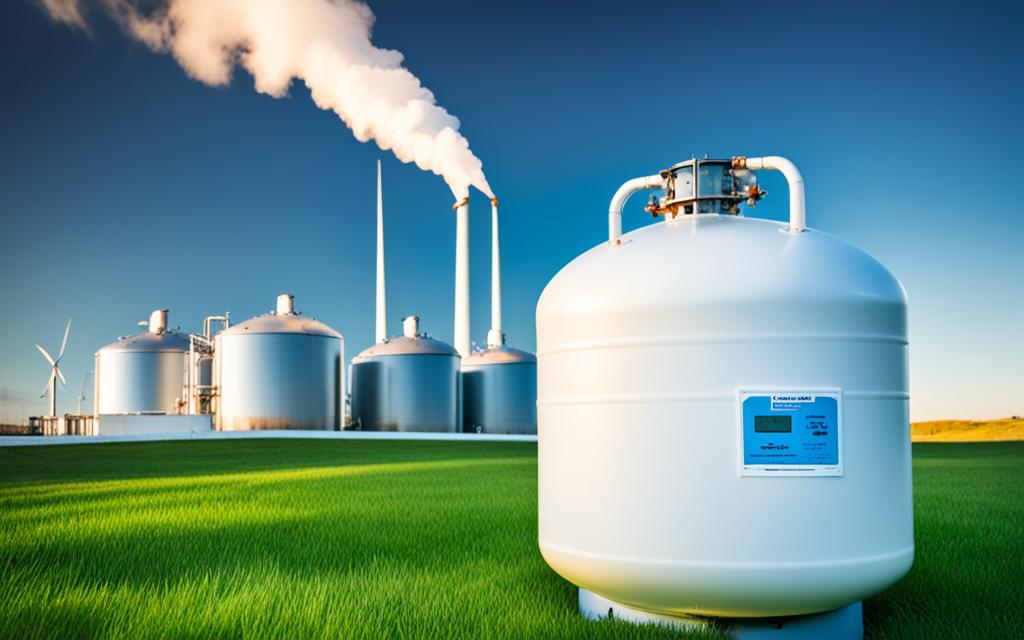
By choosing propane, individuals and businesses can actively contribute to reducing their carbon footprint. Propane emits fewer greenhouse gas emissions compared to traditional fossil fuels, promoting cleaner air and a healthier environment.
Propane is a sustainable choice that helps lower carbon emissions and fosters a more sustainable future.
Furthermore, propane offers higher energy efficiency, ensuring that more of the energy produced is effectively utilized. Its high combustion efficiency translates into reduced energy waste and lower utility bills, making it an economically attractive option.
With its wide range of applications and environmentally friendly nature, propane plays a crucial role in transitioning towards a cleaner and more sustainable energy landscape.
Propane Forecast and Inventory Levels
In 2024, the U.S. propane market is expected to witness an increase in propane inventories, which can potentially lead to lower delivery prices for residential consumers. The growing inventories indicate a positive outlook for propane supply in the country.
However, it is important to note that propane production is forecasted to decline in the latter half of 2023. This decline may have an impact on propane prices during the first half of 2024, potentially resulting in slightly higher costs for consumers.
The primary driver of propane consumption in the U.S. is residential use. As homeowners continue to rely on propane for various applications such as heating and cooking, the demand for this versatile fuel remains steady.
To gain a better understanding of the propane forecast and inventory levels, let’s take a look at the following table:
| Year | Propane Inventories (Million Barrels) | Propane Delivery Prices |
|---|---|---|
| 2022 | 75 | $1.20/gallon |
| 2023 | 80 | $1.15/gallon |
| 2024 | 85 | $1.10/gallon |
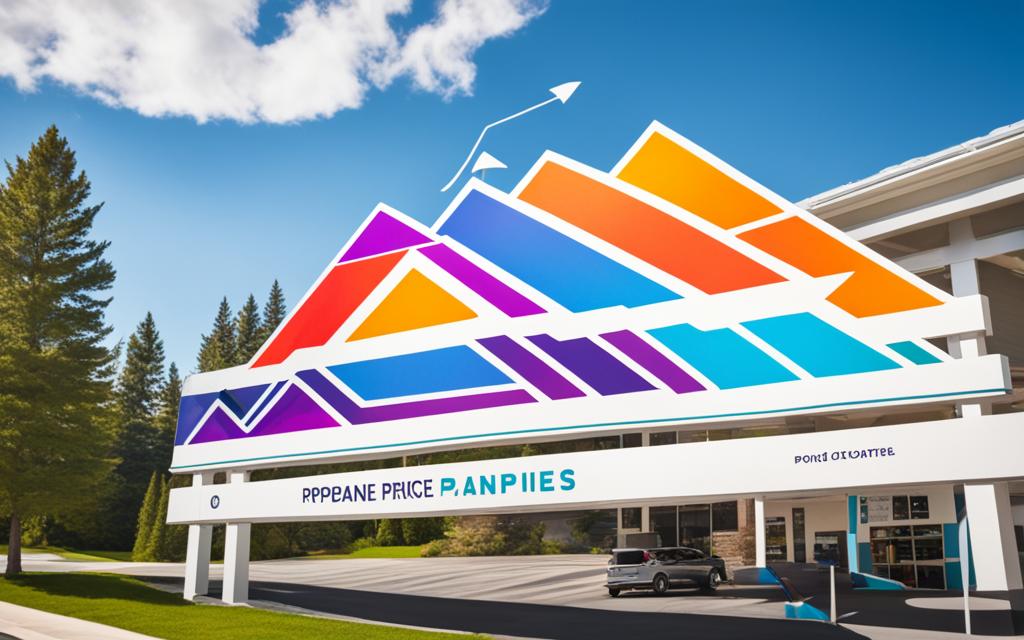
As shown in the table above, the inventory levels are projected to increase by approximately 5 million barrels from 2023 to 2024. This growth in inventories indicates a favorable supply situation, which can help stabilize or potentially lower propane delivery prices. However, it’s essential to consider other factors such as production levels and market conditions that can impact pricing.
By closely monitoring the propane forecast and inventory levels, both industry stakeholders and consumers can make informed decisions about propane utilization and anticipate potential changes in pricing.
Propane Delivery and Infrastructure
Propane delivery services are essential for ensuring a reliable supply of propane for residential, commercial, and industrial applications. Whether you need propane for heating your home, powering your appliances, or fueling your industry, efficient and timely delivery is crucial.
Propane tanks play a vital role in storing and distributing propane. These tanks come in various sizes and can be installed above or below ground to meet different needs. They provide a safe and convenient way to store propane, allowing you to access the fuel whenever you require it.
Transportation is another key aspect of propane infrastructure. Propane-powered vehicles are gaining popularity across various industries, including fleet operations, agriculture, and even school buses. These vehicles offer a cleaner and more sustainable alternative to traditional gasoline or diesel-powered vehicles, reducing emissions and contributing to a greener future.
The infrastructure supporting propane delivery includes storage facilities, transportation systems, and distribution networks. These components work together to ensure a smooth flow of propane from production facilities to end-users. Storage capacity is crucial for maintaining adequate reserves, especially during high-demand periods or unexpected disruptions in supply.
“Propane delivery services and infrastructure form the backbone of the propane industry, enabling businesses and homeowners to access this versatile and cleaner energy source.”
Having a well-established propane delivery and infrastructure network is essential for meeting the energy needs of individuals and industries alike. Whether it’s delivering propane to heat homes during the winter months or powering propane-driven vehicles for transportation, a reliable infrastructure ensures consistent supply and helps drive the adoption of propane as a viable energy option.

Benefits of Propane Delivery and Infrastructure:
- Provides a reliable supply of propane for various applications
- Facilitates convenient storage and distribution of propane through tanks
- Supports the growing use of propane-powered vehicles for cleaner transportation
- Enables efficient and timely delivery of propane to end-users
- Contributes to a more sustainable and environmentally friendly energy solution
Propane Market Challenges and Export Capacity
The propane market faces several challenges that impact pricing and market dynamics. These challenges include stagnant export capacity, oversupply, and elevated inventories. Additionally, the heavy reliance on exports to clear excess production puts pressure on propane prices. Any imbalances between supply and demand can have significant effects on the market.
The export capacity of Liquefied Petroleum Gas (LPG) in the Gulf Coast is not expected to see significant expansion until 2025. This limited export capacity restricts the ability to clear surplus propane from the market efficiently.
Furthermore, the oversupply and elevated inventories in the propane market contribute to pricing fluctuations. The abundant supply creates downward pressure on prices, especially when demand fails to match the available stock.
To better understand the challenges facing the propane market, let’s take a closer look at the export capacity in the Gulf Coast, as well as the impact of oversupply and high inventories on propane pricing.
Export Capacity Challenges
The Gulf Coast plays a vital role in propane exports, as it is a major hub for LPG production and distribution. However, the export capacity in this region has not seen substantial expansion, leading to limited opportunities for clearing excess propane from the market.
The lack of significant export capacity expansions until 2025 restricts the market’s ability to address oversupply conditions effectively. This limitation can result in price volatility and challenges in maintaining stable pricing for propane.
Oversupply and Elevated Inventories
Oversupply in the propane market occurs when the production of propane exceeds the demand for the product. This excess supply, combined with limited export capacity, leads to accumulation in inventories.
The accumulation of propane inventories not only increases storage costs but also puts downward pressure on prices. With more propane available than the market demands, suppliers may need to lower prices to stimulate sales and clear excess stock.
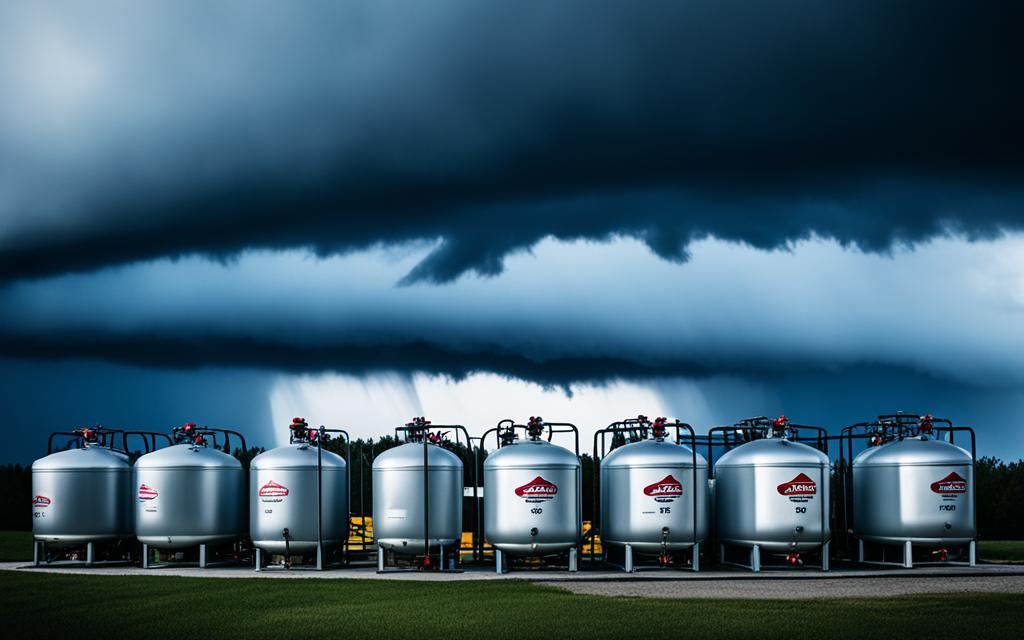
In summary, the challenges faced by the propane market include stagnant export capacity, oversupply, and elevated inventories. These factors contribute to pricing fluctuations and impact the overall dynamics of the propane market. Addressing these challenges will require a balanced approach that considers production, demand, and export capacity.
Propane’s Environmental Benefits
Propane is widely recognized as a clean and environmentally friendly fuel option. With its lower carbon emissions compared to other fossil fuels, propane offers a sustainable energy solution that contributes to reducing greenhouse gas emissions and minimizing environmental impact.
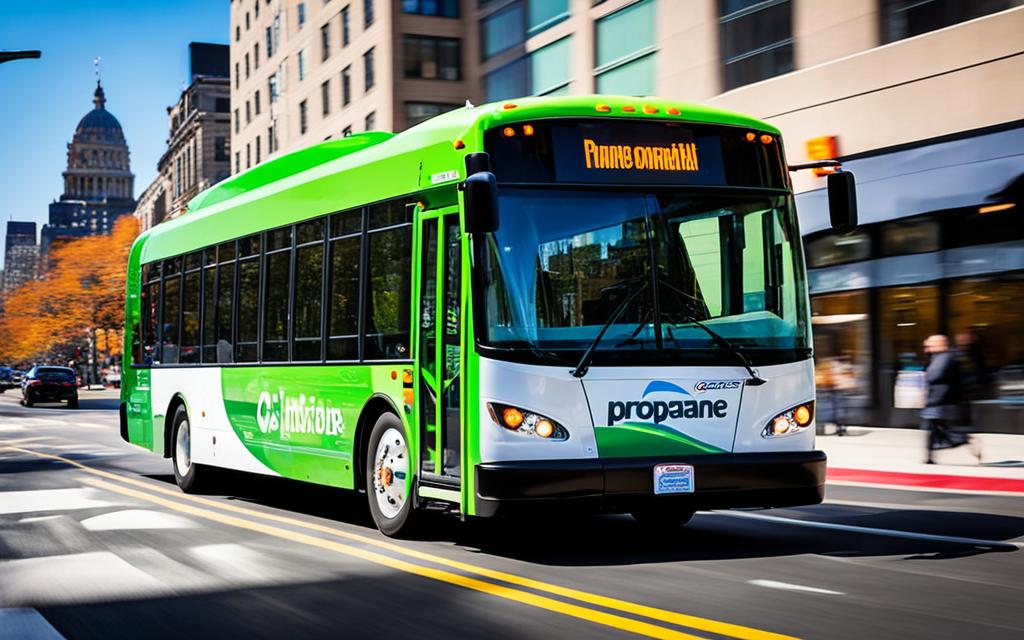
One significant application of propane’s clean properties is in the transportation sector. Propane-powered buses and vehicles are gaining traction as a cleaner alternative to traditional gasoline or diesel-powered vehicles. These propane-powered vehicles not only help in reducing carbon emissions but also offer a more sustainable and efficient mode of transportation. They play a crucial role in improving air quality, especially in densely populated areas where emissions from vehicles can significantly impact the environment and public health.
The Advantages of Propane as a Clean Fuel
Propane offers several advantages as a clean fuel:
- Lower carbon footprint: Propane combustion produces fewer carbon dioxide (CO2) emissions compared to other fossil fuels. By choosing propane for various applications, individuals and businesses can actively contribute to reducing their carbon footprint and combatting climate change.
- Clean-burning: Propane burns much cleaner than traditional fuels, with minimal harmful emissions such as sulfur dioxide (SO2), particulate matter, and nitrogen oxide (NOx). The clean-burning characteristics of propane contribute to better air quality and reduced environmental pollution.
- Energy efficiency: Propane exhibits excellent energy efficiency, meaning it can deliver more usable energy with less waste compared to other fuels. This efficiency translates to lower energy consumption and reduced overall environmental impact.
The combination of propane’s lower carbon emissions, clean-burning characteristics, and energy efficiency makes it an attractive option for a wide range of applications, including residential, commercial, and industrial use.
Incorporating propane-powered vehicles into public transportation systems can significantly reduce carbon emissions and improve air quality in urban areas.
Propane-Powered Buses: A Sustainable Alternative
Propane-powered buses have become a sustainable alternative in the transportation sector, providing numerous benefits:
- Lower emissions: Propane-powered buses emit less CO2, NOx, and other harmful pollutants compared to conventional diesel buses. This reduction in emissions contributes to cleaner air quality and a healthier environment.
- Quiet operation: Propane engines operate more quietly than diesel engines, reducing noise pollution and providing a more pleasant experience for passengers and communities.
- Cost-effectiveness: Propane-powered buses offer cost savings over the long term. Propane is typically less expensive than diesel fuel, and its cleaner combustion leads to reduced maintenance and extended engine life.
The adoption of propane-powered buses is gaining momentum as transit agencies recognize the value of cleaner and more sustainable transportation options. These buses provide an excellent opportunity to reduce carbon emissions from public transportation systems while improving overall efficiency and air quality.
| Advantages of Propane-powered Buses | Benefits |
|---|---|
| Lower carbon emissions | Contributes to reducing greenhouse gases and addressing climate change |
| Improved air quality | Reduces harmful pollutants, leading to better public health |
| Quiet operation | Reduces noise pollution in urban areas |
| Cost-effectiveness | Savings on fuel costs and reduced maintenance expenses |
Propane Supply and Demand Outlook
The dynamics of supply and demand have a significant impact on the propane market, shaping both pricing trends and the overall industry outlook. Several key factors influence the balance between supply and demand, including propane inventories, domestic production levels, export capacity, and weather conditions. A careful analysis of these factors enables experts to forecast the future of the propane industry and predict pricing trends.
Factors Affecting Supply and Demand
1. Propane Inventories:
Monitoring the levels of propane inventories helps industry experts gauge the available supply and potential shortages. High inventories indicate an abundance of propane, contributing to stable or lower pricing. On the other hand, low inventories can lead to increased demand and higher prices.
2. Domestic Production:
The volume of propane produced domestically plays a significant role in the supply and demand balance. Higher levels of production can lead to greater supply and potentially lower prices. Conversely, decreases in production may result in a tighter supply, potentially leading to increased prices.
3. Export Capacity:
The export capacity of propane affects the market dynamics by diverting supply to international markets. Higher export capacity can reduce the domestic supply and elevate prices, while limited export capacity may result in more propane available for domestic consumption, potentially leading to lower prices.
4. Weather Conditions:
Weather events, such as extremely cold winters or hurricanes, can significantly impact propane demand. Severe weather conditions often drive up the need for propane, especially for heating purposes. Conversely, milder weather conditions may reduce demand and, in turn, influence pricing trends.
Propane Supply and Demand Forecast
Based on current industry analysis and market trends, the propane supply and demand outlook for the foreseeable future remains dependent on these key factors. Propane inventories, domestic production levels, export capacity, and weather conditions will continue to shape the market dynamics and pricing trends. Monitoring these indicators will allow industry participants to make informed decisions and adapt to potential changes in the propane industry.
Ultimately, staying abreast of the propane supply and demand forecast is crucial for industry stakeholders, as it provides insights into pricing expectations and the overall health of the market.
| Year | Propane Supply (Million Gallons) | Propane Demand (Million Gallons) |
|---|---|---|
| 2022 | 250 | 230 |
| 2023 | 260 | 235 |
| 2024 | 265 | 240 |
| 2025 | 270 | 245 |
Future of Propane Prices in Conclusion
The future of propane prices is influenced by various factors, including supply and demand dynamics, export capacity, production levels, and market conditions. Understanding these factors and monitoring market trends and industry analysis can provide valuable insights into the future trajectory of propane prices.
While forecasts indicate some fluctuations in prices throughout 2024, the long-term outlook will depend on how these factors evolve. Supply and demand dynamics play a crucial role in determining price levels, with imbalances leading to price variations. Export capacity also impacts propane prices, as it affects the ability to clear excess production and find new markets.
Propane production levels are another significant factor to consider. The United States has seen a significant increase in propane production in recent years, shifting from being a net importer to a net exporter. Monitoring production trends and changes in domestic supply can provide insights into future propane prices.
Market conditions and external factors, such as weather events and global economic trends, can also impact propane prices. Weather events like winter storms or hurricanes can increase demand and tighten supply, leading to price spikes. Economic factors, including changes in crude oil and natural gas prices, can also influence propane prices.
In conclusion, the future of propane prices is subject to a combination of factors that interact and shape the market. Supply and demand dynamics, export capacity, production levels, and market conditions all play a role in determining propane prices. Monitoring industry analysis and market trends is essential for gaining a deeper understanding of the future trajectory of propane prices.
Conclusion
In conclusion, the propane market in 2024 is expected to face challenges driven by supply and demand imbalances, stagnant export capacity, and elevated inventories. Price forecasts indicate that propane prices may experience fluctuations throughout the year. However, the long-term outlook for propane costs will be influenced by factors such as production levels, export capacity expansions, and overall market conditions.
Stakeholders in the propane industry can navigate these challenges by closely monitoring market trends and conducting thorough industry analysis. By staying updated on propane price forecasts and understanding the evolving propane market trends, businesses can make informed decisions to manage their costs and optimize their operations.
As the future of propane prices unfolds, it will be essential for industry participants to adapt to changing market dynamics and explore opportunities for growth and efficiency. By leveraging market insights and employing strategic pricing strategies, stakeholders can position themselves competitively in the propane market of the future.






























